Report

Executive Summary
For China’s fast-moving consumer goods (FMCG) industry, urban shoppers’ total spending in the first half of 2018 grew by 3.3%. This was much higher than the 2% growth observed between the first half of 2016 and the first half of 2017, confirming the recovery observed in H2 2017. Overall, a 1.3% FMCG volume decline was offset by a 4.6% rise in average selling price.
In a trend that we have been tracking for six years, the sales performance reflects China’s “two-speed” growth trajectory, with personal and home care growing at a much faster rate than food and beverages.
Written in collaboration with
Written in collaboration with

Some food and beverage brands managed to outperform by introducing healthier and higher-quality products. For example, new varieties that appeal to nutrition-conscious consumers helped the instant noodle category grow 4.1% in value, and the carbonated soft drinks (CSD) category 5.8% in H1 2018.
Yet, it was personal care categories that rose above all in the first half of 2018. While volume declined by 2%, selling prices grew dramatically—11.5% on average—to contribute to 9.3% value growth, nearly three times the FMCG average. Niche products in skin care and makeup, such as cosmeceuticals and natural products, served as the driving force behind the premiumization.
The strong performance also reflects the successful entry of local insurgent brands, which gained share from local and foreign brands alike. Indeed, Chinese local insurgents are making their presence known, capturing a disproportionate share of the FMCG growth. These brands have a clear vision and an entrepreneurial mission to fulfill unmet needs for Chinese consumers. They take a distinctly Chinese approach to building their brands and make their record-setting gains by moving at Chinese speed.
We analyzed the performance of 46 local FMCG insurgent brands. We excluded retail-oriented insurgent brands such as Luckin Coffee (瑞幸咖啡), HeyTea (喜茶) and BlissCake (幸福西饼). While half of the selected insurgent brands have annual (urban) revenues between RMB 100 million and RMB 500 million, they are growing phenomenally fast. Sixty-seven percent of them grew at least two times faster than their category average. These local insurgents also typically sell their products for above-average prices. While these brands only represent roughly 6% market share across the 33 categories they disrupt, they delivered nearly 20% of the value growth from 2015 to 2017 in these categories.
However, China’s dynamic FMCG market is a revolving door, with many brands coming and going. For example, our research identified 276 individual brands of skin care in 2013. Four years later, 27% of those brands were no longer in the market or had negligible market presence. Still, some insurgent brands proved that it has been possible to sustain high growth relatively consistently in the past five years—a long time in China’s swiftly changing market—and, in some cases, challenge the market leadership position. A single, dramatic example: Pechoin (百雀羚) rose from the No. 10 player to the No. 1 player in skin care, with 56% annual growth from 2013 to 2015 and 19% from 2015 to 2017.
How do companies like Pechoin (百雀羚) do it? We found that roughly 80% of insurgents’ value growth results from volume growth and 20% from price growth. This finding is in stark contrast to the overall FMCG market, with its stagnant volume growth and rising prices. Penetration is the single biggest component in insurgents’ volume growth—not frequency or volume per trip.
Insurgents benefit from three major external factors: digitalization that has lowered the barriers to entry; China’s “New Retail,” which is redefining the roles of consumers, merchandise and stores; and Chinese consumers’ growing preference for products that improve their lifestyle, health and wellness.
We observe that insurgents making the most of these external factors exhibit traits of what we refer to as a Founder’s Mentality ®: an insurgent mission, a frontline obsession and an owner’s mindset. We see this in three important areas.
First, local insurgents rely on consumer-focused innovation in product, branding and assortment. Among their successful moves in product assortment: They focus on a few proven “hero” SKUs or product variants to eliminate unnecessary product complexity and ensure that the young brands’ limited resources are devoted to a very focused message to the target consumers. YunNan BaiYao (YNBY, 云南 白药), with its Mint and Spearmint toothpastes, is a good example of this.
Second, they take a localized approach to route-to-market and marketing. For example, without established offline distribution relationships, many insurgents focus on high-traffic online platforms such as Tmall and JD.com, and are quick to use up-and-coming social commerce and social media platforms like Pinduoduo (拼多多) and TikTok (Douyin, 抖音). Also, more than half of the insurgents we evaluated, like ChaoNeng (超能) in fabric detergent, launched their products in lower-tier cities first, a move that enabled them to avoid early competition from multinational brands.
Finally, they create a nimble and agile operating model. Their lean, cross-functional organizations give them the flexibility and the freedom to adapt in-market. Instead of waiting for multilayers of discussions and approvals, insurgent brands can move quickly. Their local knowledge and entrepreneurial culture allow them to decide and adapt quickly to market changes. They test and learn—and rapidly change course as needed without locking in significant capital expenditures. By establishing an ecosystem of partnerships, including co-manufacturers and co-marketers, insurgents remain asset light themselves.
Instead of continuing to lose so much growth to these newcomers, incumbents can compete more effectively by adopting three critical ingredients of insurgents’ success. We call it the 3D approach.
Design for Chinese consumers. Chinese FMCG consumers are unique among their counterparts in other markets. They also are changing fast. Incumbents—especially multinationals—need to localize in everything from product design to branding to marketing. While global experience is important, what is often more valuable is a local team that deeply understands both the Chinese culture and the latest trends: the significance of Traditional Chinese Medicine, for instance, or the shopping behaviors of the Chinese millennials born under the one-child policy.
Decide in China. The Chinese FMCG market is moving so fast that there’s no time for decisions to travel from the local to regional to global headquarters for approval. Multinationals need to delegate innovation, marketing, distribution and other decisions affecting their China business to their China teams as well as change their incentive systems to be more in line with local insurgents.
Do it at Chinese speed. While incumbent brands by nature are typically less nimble than insurgents, they can take two proven approaches to boost their ability to act quickly on market opportunities. First, they can learn from scale insurgents like Alibaba and Tencent, which grew fast by leveraging an ecosystem. For example, an FMCG company can focus on core functions such as product development and marketing while relying on players in an ecosystem for other functions such as manufacturing and distribution. The other way to move swiftly to compete against insurgents: deploy micro-battles. These are small, achievable battles that later can be scaled. The micro-battle approach involves an extremely focused initiative that starts by attacking the hardest problem first and iterates on the solution. Cross-functional teams test and learn, with a willingness to fail quickly and adapt. It is a crucial mindset for getting on (or, getting back on) the fast track in China’s two-speed FMCG market.
Full report
“Two speed” in a stabilizing market
China’s fast-moving consumer goods (FMCG) industry experienced slower overall growth in the first half of 2018 following the strong recovery in the second half of 2017. Urban shoppers’ total spending grew by 3.3%. The apparent slowdown was partly the result of pre-load—year-end purchases in the last months of 2017. Another contributing factor: a distinct decline in gifting during the 2018 Chinese New Year. However, the 3.3% growth rate was much higher than the 2% growth observed between the first half of 2016 and the first half of 2017, confirming the recovery observed in H2 2017. Once again, in a trend that we have been tracking for six years, the sales performance reflects China’s two-speed growth trajectory, with personal and home care growing at a much faster rate than food and beverage (see Figure 1).
Fast-moving consumer goods (FMCG) growth remained low, while two-speed growth between food and beverage vs. personal and home care continued

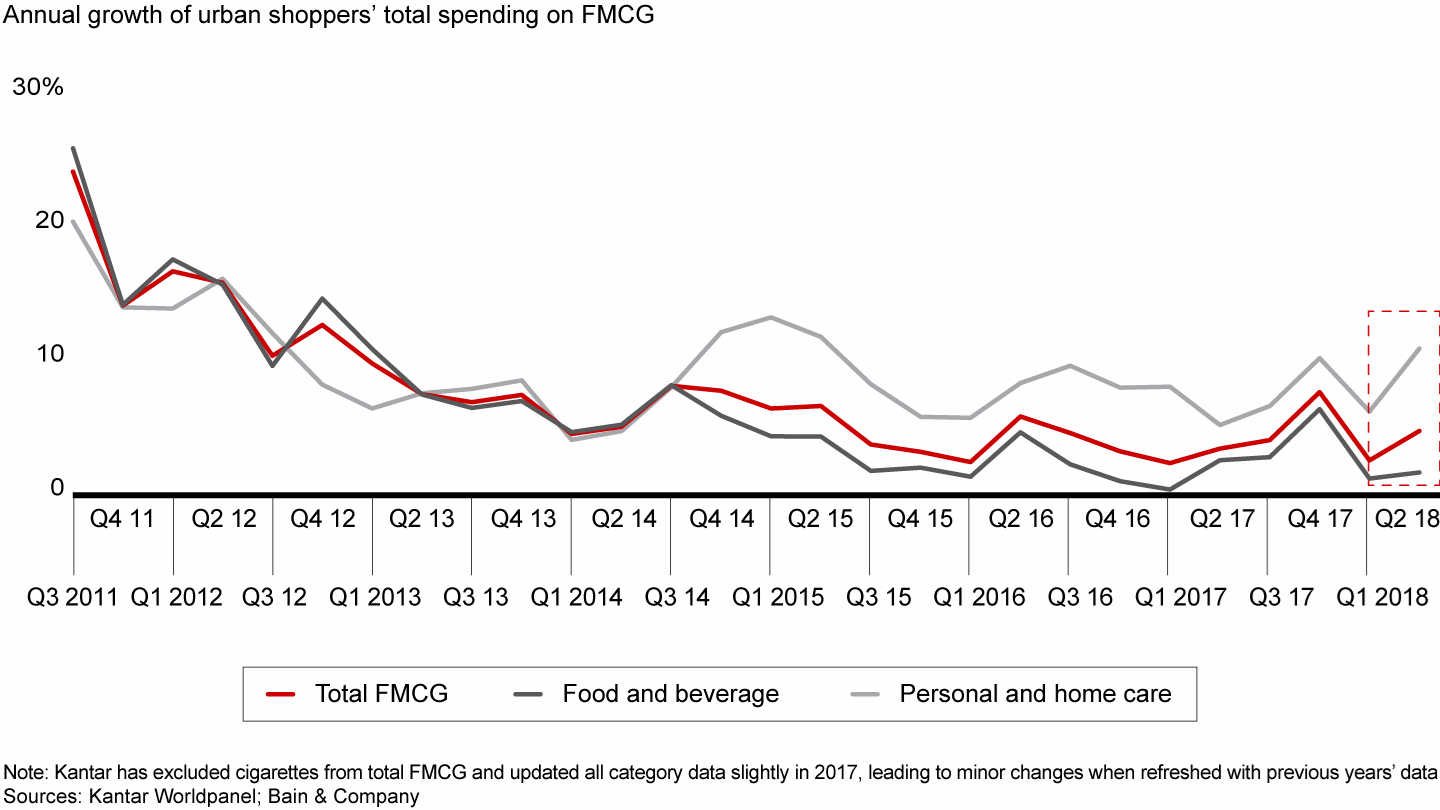
Overall, the 4.6% rise in FMCG average selling price (ASP) offset a 1.3% volume decline (see Figure 2) to deliver the 3.3% value growth. Viewed on its own, offline performance was even more disappointing. Offline FMCG value growth dropped to 1.2% due to a 2.4% volume decline and 3.7% ASP growth.
FMCG volume dropped but selling prices rose, leading to low value growth

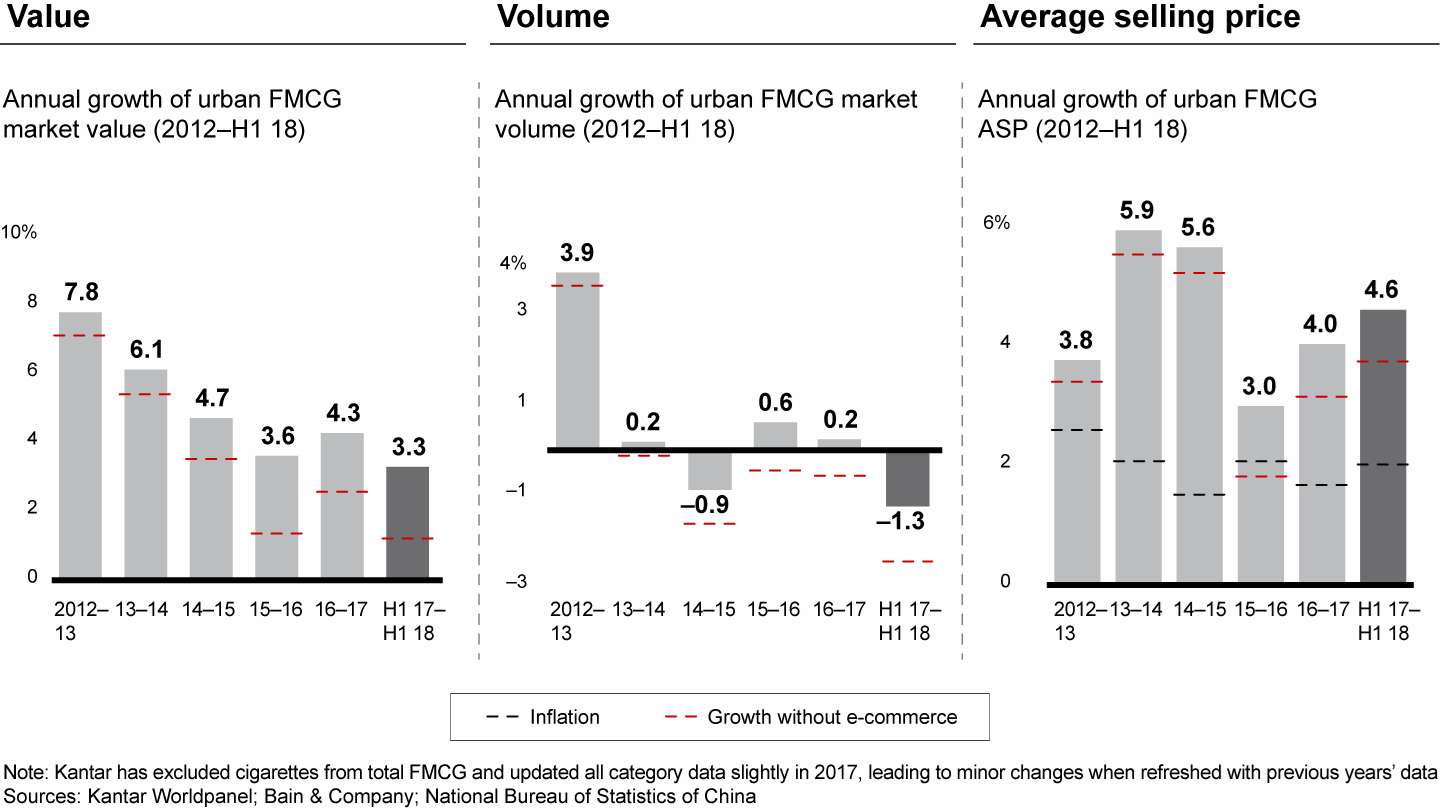
As in each of the past six years, we studied 106 FMCG categories purchased for home consumption in China, conducting a deep analysis of the key 26 categories that span the four largest consumer goods sectors: packaged food, beverages, personal care and home care.1 Combined, these sectors represent 80% of China’s FMCG purchases. This report, which updates the findings from China Shopper Report 2018, Vol. 1, As Shoppers Upgrade, Growth Returns, includes Kantar Worldpanel shopper behaviors data for the first half of 2018. The new data provides insights into continuing trends that are critical for brands as they set a course for growth in the world’s largest FMCG market.
As we have seen for years now, packaged food and beverage categories took a noticeably different growth trajectory than personal care and home care categories. Packaged food and beverages showed weaker performance, with dropping volumes contributing to lower value growth (see Figure 3).
Beverage and packaged food values suffered from volume decline, while higher prices boosted value growth for some packaged foods

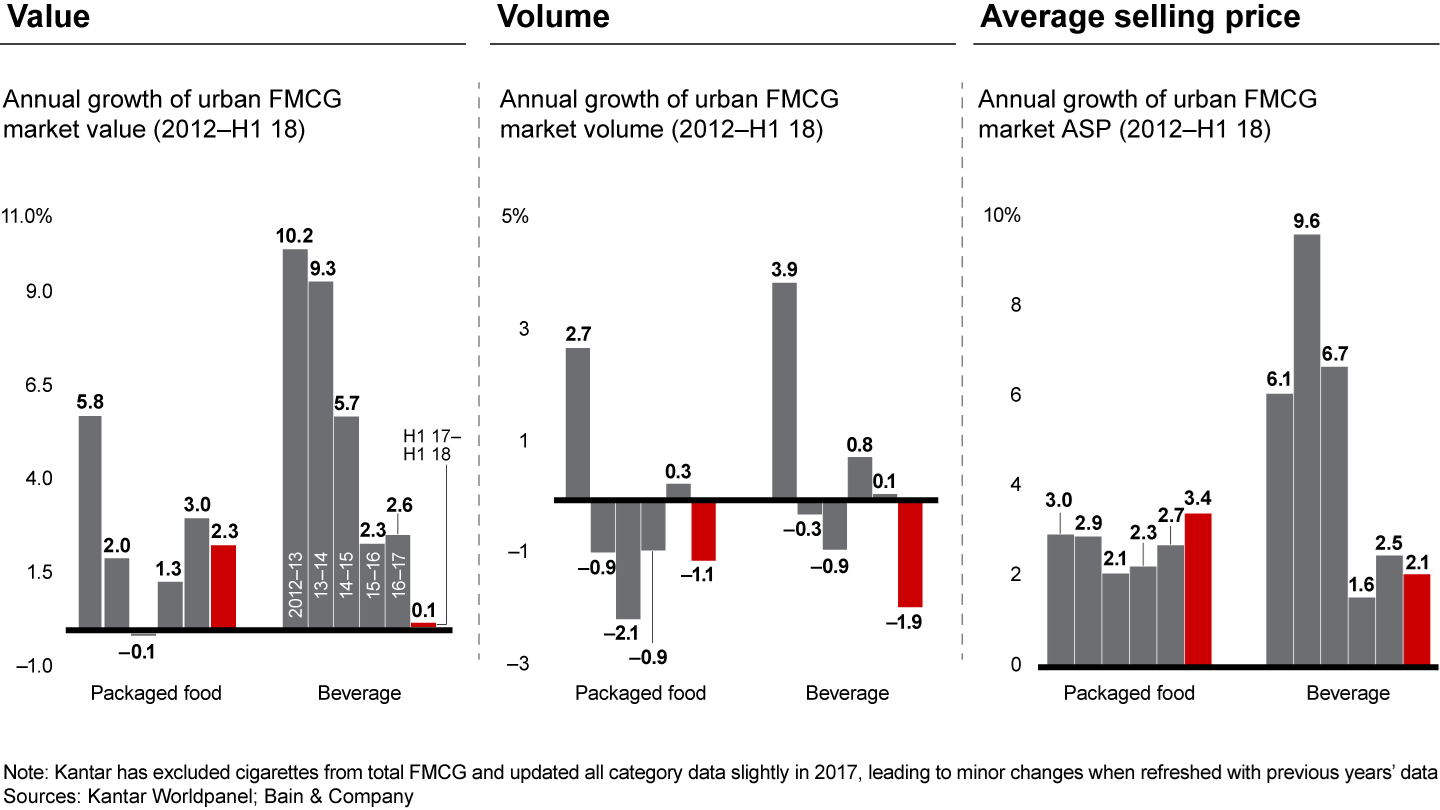
Some brands managed to outperform by introducing healthier and higher-quality food or beverages. For example, new varieties that appeal to nutrition-conscious consumers helped the instant noodle category grow by 4.1% in value in H1 2018, driven by the introduction of more premium SKUs by leading brands, like Golden Soup (金汤系列) from Master Kong (康师傅) and Magic Soup (汤达人) from Uni-President (统一). Similarly, the CSD category enjoyed a healthy 5.8% growth in H1 2018 through the growth of small packs and the success of healthier SKUs such as Sprite Fiber from Coca-Cola. Premium brands in yogurt, juice and milk still gained ground. But lower import taxes limited the growth in selling prices for the overall beverage category. Yet while some brands were able to command slightly higher prices by introducing healthier and higher-quality offerings, the increase was not enough to counter the effect of overall declining volume in food and beverage categories.
By comparison, home care and personal care outperformed. In home care, rising volumes and selling prices led to 5.5% value growth (see Figure 4). Among the factors at play: The increase in input costs in some categories, like pulp, led to higher prices for toilet tissue and facial tissue.
Higher prices led to higher value growth in personal care, while home care experienced both volume and price growth

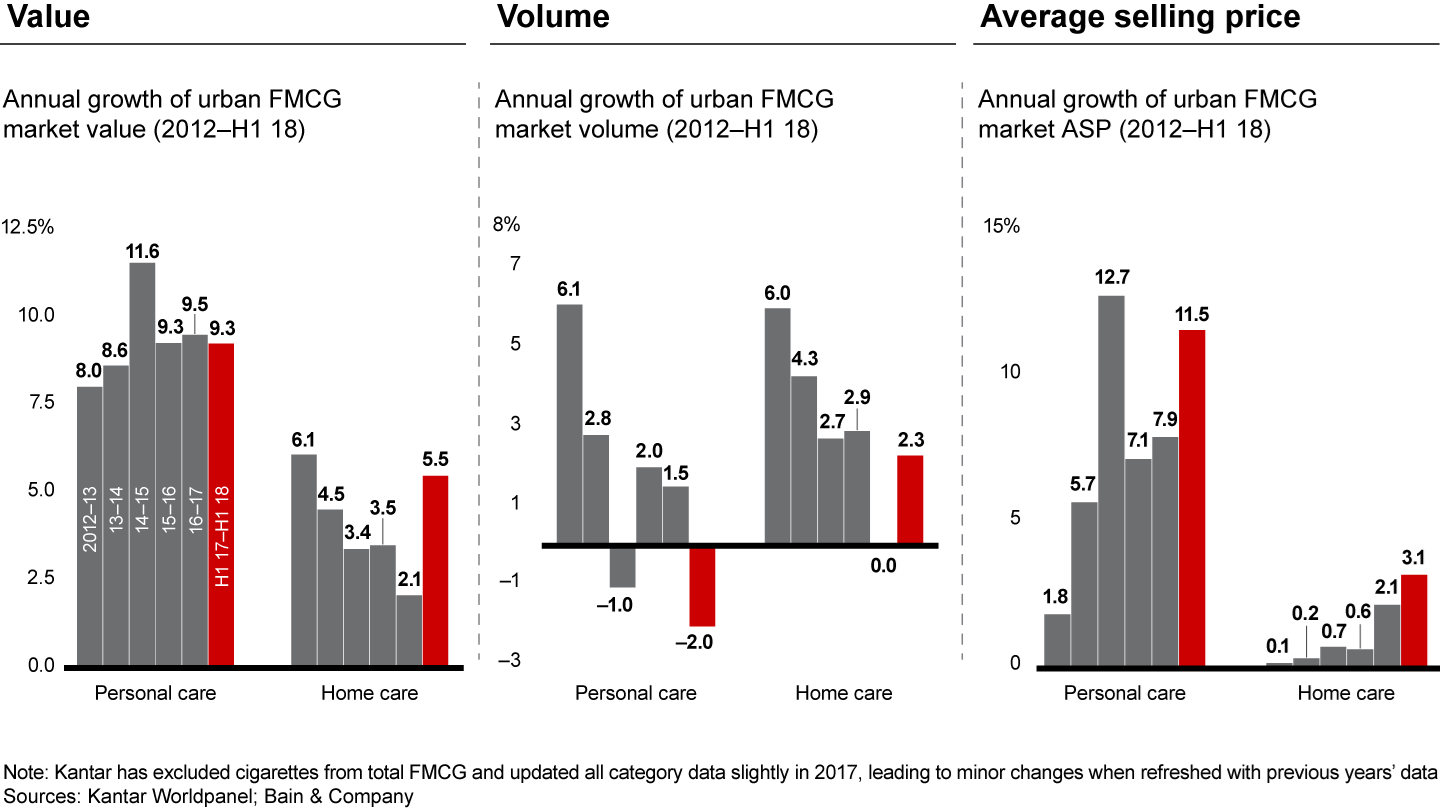
However, it was personal care categories that rose above all in the first half of 2018. While volume actually dropped by 2%, selling prices grew dramatically—11.5% on average—to contribute to 9.3% value growth, nearly three times the FMCG average. Niche products in skin care and makeup, such as cosmeceuticals and natural products, served as the driving force behind the premiumization. The strong performance also reflects the successful entry of local insurgent brands, which gained share from local and foreign brands alike.
Enter the local insurgents
Why insurgent brands matter. Marie Dalgar (玛丽黛佳). Three Squirrels (三只松鼠). One Leaf (一叶子). Unifon (御泥坊). An army of dynamic young brands bearing these and other newly popular names is capturing a disproportionate share of the growth in China’s FMCG market, threatening to radically change the rules for incumbents. As we have reported for six years, local Chinese FMCG brands, in aggregate, have been gaining market share from foreign brands across most product categories. With 7.7% value growth in 2017, local brands represented 98% of market share growth. Now it is the local insurgent brands that are making headlines by earning more than their share of that local growth.
These brands have a clear vision and an entrepreneurial mission to fulfill unmet needs for Chinese consumers, whether it is for healthy, lifestyle or eco-friendly products. They take a distinctly Chinese approach to building their brands and make their record-setting gains by moving at Chinese speed.
To better understand the insurgent phenomenon—to determine who these winners are and why they are booming—we analyzed FMCG brand sales growth and category performance data from Kantar Worldpanel, interviewed consumer products and retail industry experts, analyzed key brands’ financial documents and conducted proprietary research. We focused our efforts on 46 important FMCG insurgents representing 33 subcategories. These are locally owned, independent brands or conglomerate-owned brands that operate separately and are outpacing subcategory growth with revenue growth in excess of 10% from 2015 to 2017 (to see the full list of insurgents analyzed, see Figure 5). We excluded retail-oriented insurgent brands such as Luckin Coffee (瑞 幸 咖 啡), HeyTea (喜 茶) and BlissCake (幸福西饼).
We analyzed 46 insurgent brands from 33 subcategories

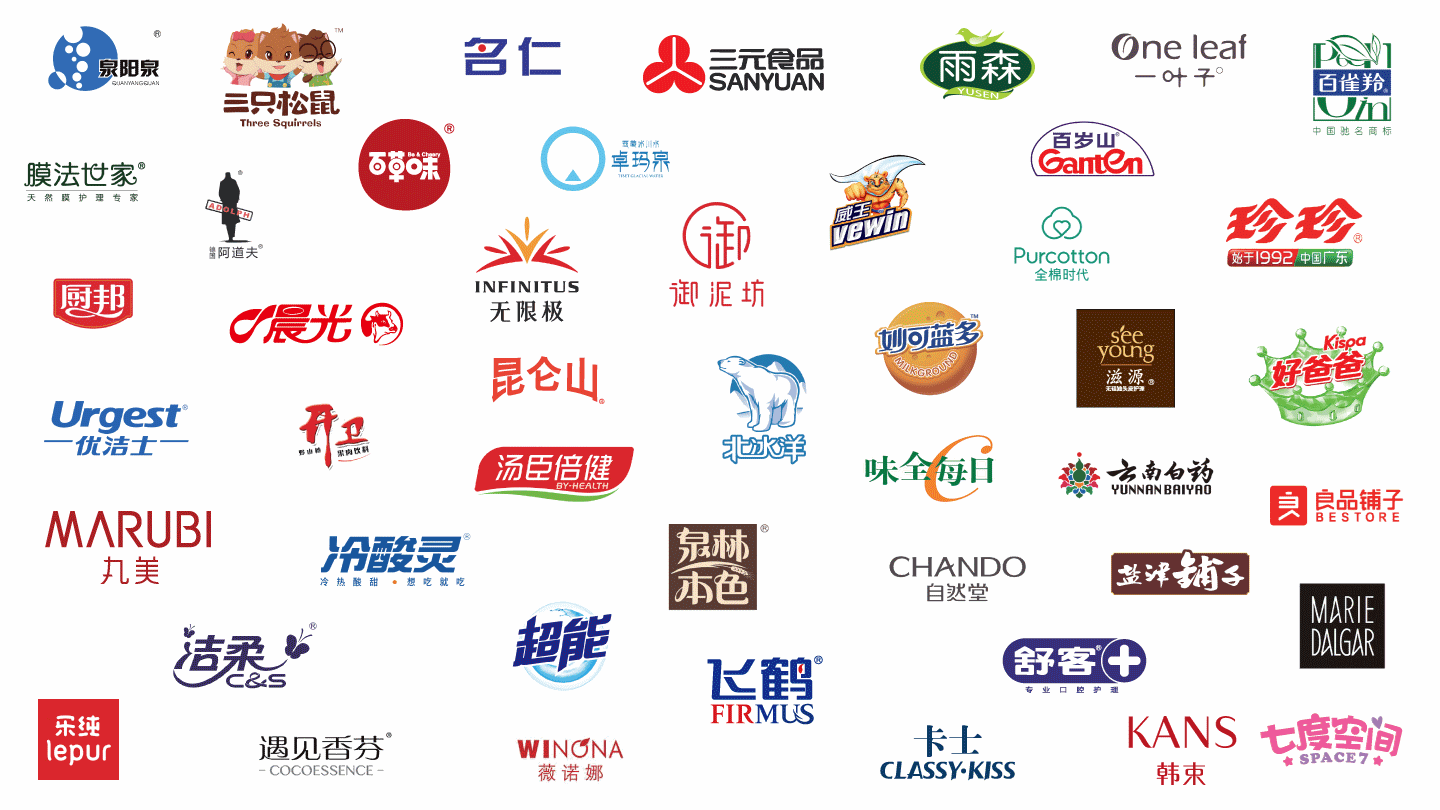
Most local insurgents are small—about half of them have urban revenues in the RMB 100 million to RMB 500 million range. However, they are quickly gaining ground. Sixty-seven percent of them grew at least two times faster than their category average (see Figure 6). They either target “premium” consumers (those who tend to value quality over price) or the “good-enough” segment (where both price and quality matter). As such, these local insurgents typically sell their products for above-average prices. Moreover, while these brands only represent roughly 6% market share across the 33 categories they disrupt, they contributed disproportionately to the category growth, delivering nearly 20% of the revenue growth from 2015 to 2017 in these categories (see Figure 7). And they are doing it at a historically swift pace. Consider that it took YNBY (云南白药) just five years to gain an additional 5% market share in China’s toothpaste category and become the No. 1 brand in 2016. It took four years for local insurgent SAKY (舒克) to leapfrog from the No. 14 spot to become the No. 2 player in toothbrushes.
Most insurgent brands may be small, but they outgrow their subcategories

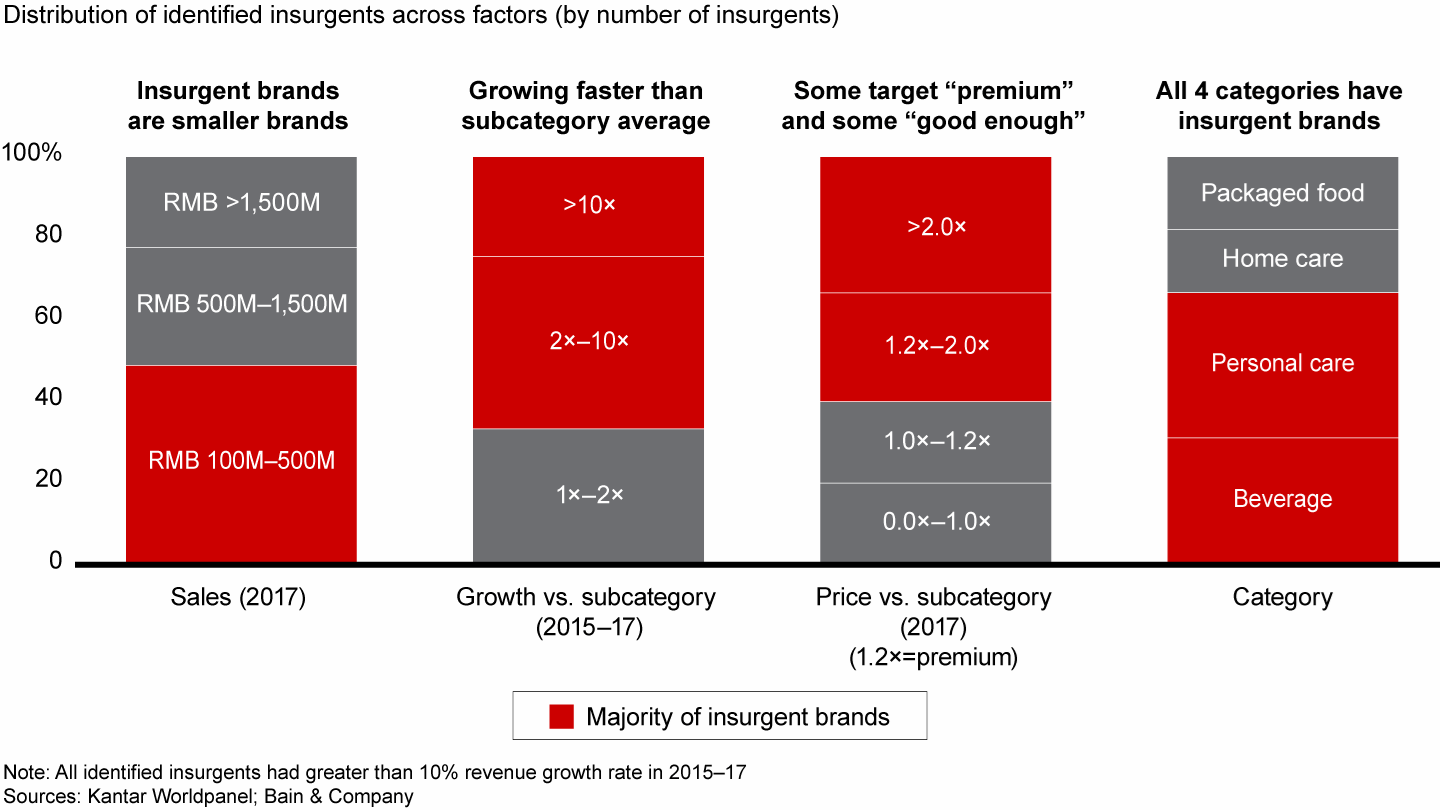
Insurgent brands account for 6% of the total revenue in 33 subcategories but captured 20% of the revenue growth from 2015 to 2017

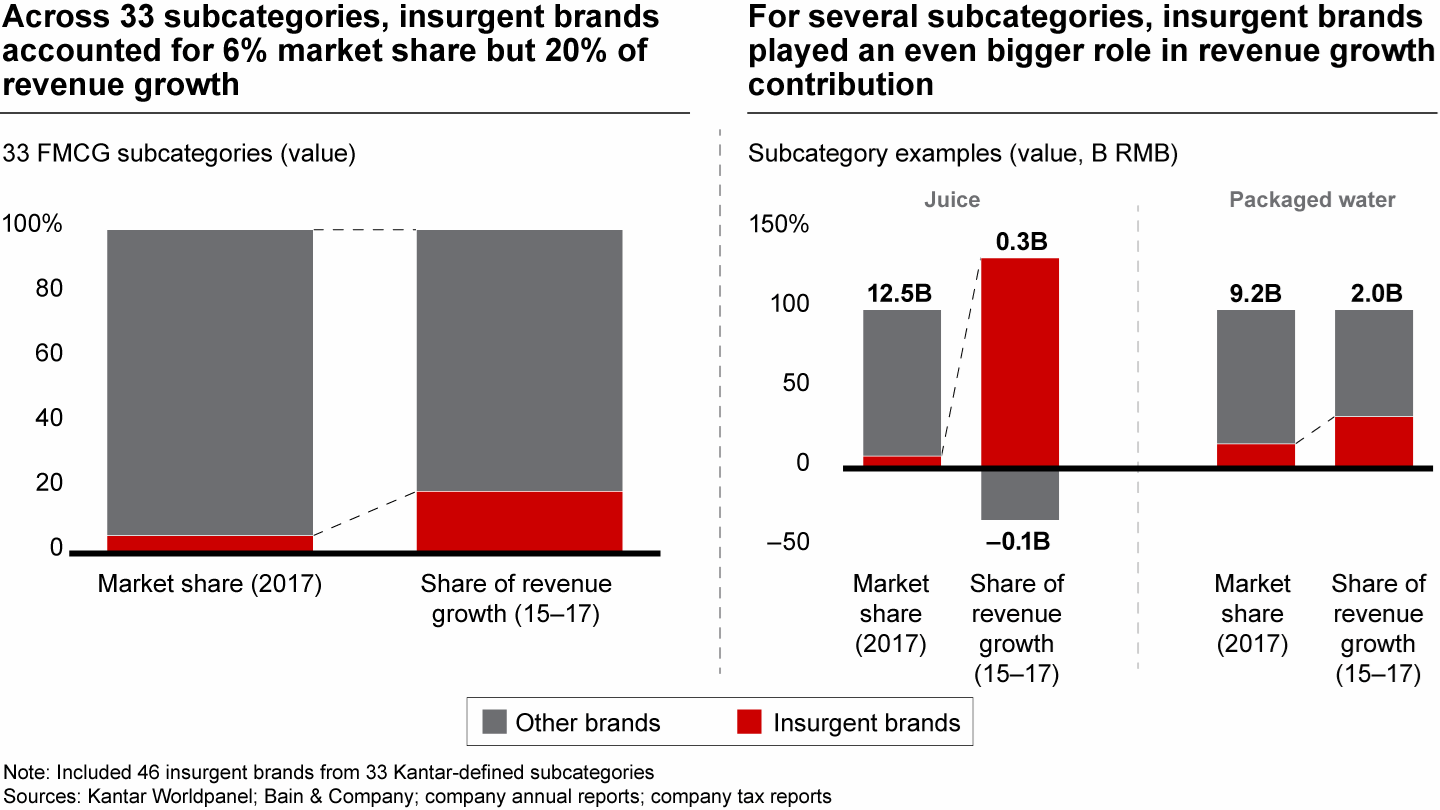
How insurgents grow
So how do they do it—get so far so fast?
Understanding China’s boom-or-bust market. First, it is important to realize that for every YNBY (云南白药) or SAKY (舒克) there are dozens of local insurgents that either never make it or exit in a boom-and-bust cycle. Most of China’s FMCG categories are dynamic, with a steady stream of brands coming and going each year. One consequence of this fluidity is that this year’s spectacular insurgent success relatively easily can be displaced to become next year’s sensational loser. To catch a glimpse of China’s market dynamics, look at the revolving door in skin care and makeup. In 2013, Kantar Worldpanel identified 276 individual brands of skin care. Four years later, 27% of those brands were no longer in the market or had negligible market presence. Makeup had a similar rate of attrition: During the same time, 22% of the brands were no longer in the market or had negligible market presence (see Figure 8).
In China’s dynamic FMCG industry, today’s winning brands could become tomorrow’s memory

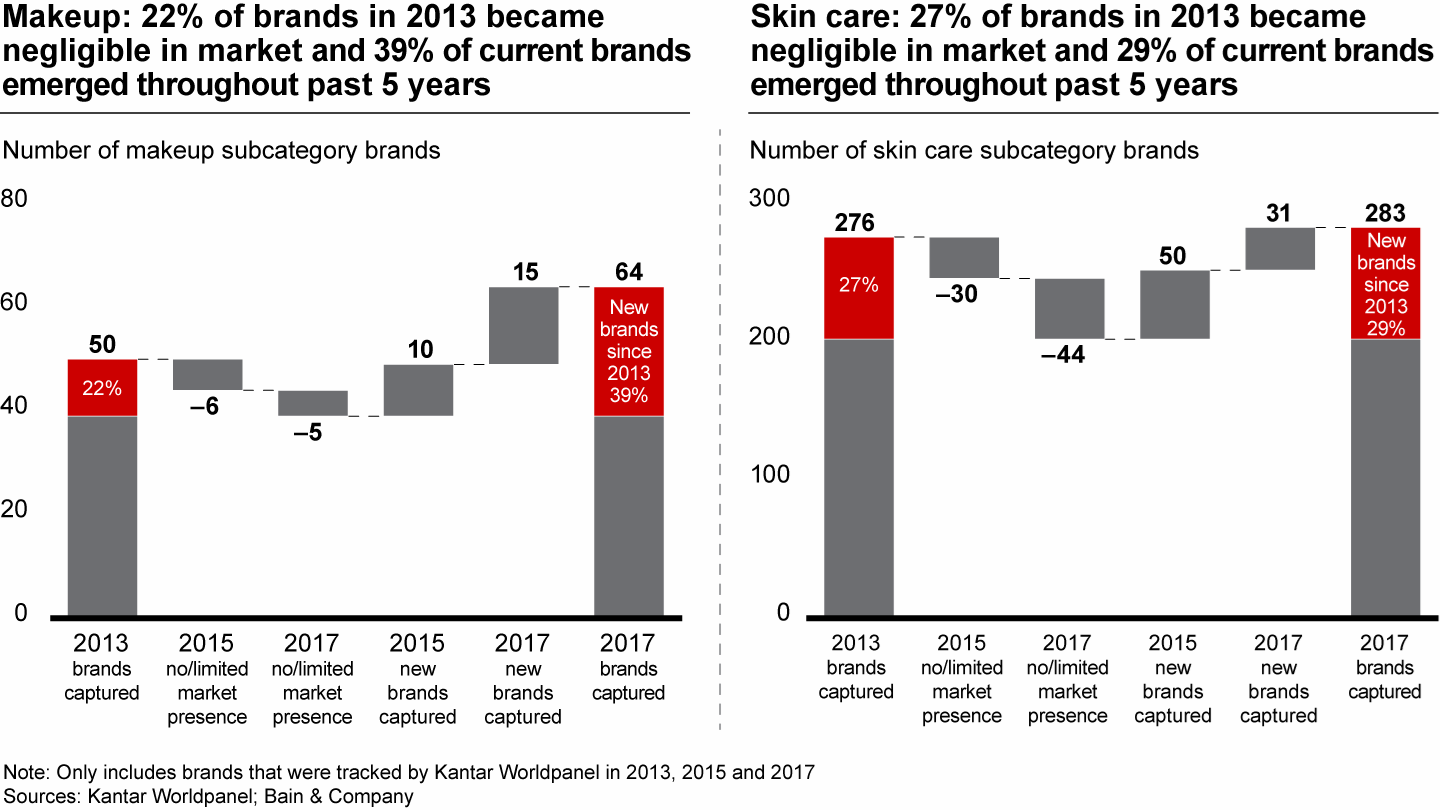
We tracked the fates of 29 high-growth insurgent brands in the years 2013 to 2015. In 2015 to 2017 about half of them failed to maintain their more than 10% growth rate and nine actually suffered negative growth. Many factors come into play. While the overall FMCG growth slowdown accounts for part of the disappointing performance, some new brands fell victim to wrong channel strategy decisions, heavy debt incurred in overly ambitious expansion and an inability to innovate their products to respond to the rapidly changing needs of consumers.
Blue Moon (蓝月亮), a brand covering fabric detergent, fabric softener, kitchen cleanser and personal wash categories, enjoyed 11% growth in 2013–15 but endured a negative 3% CAGR the following two years. In 2015, the company decided to exit most of its offline distribution channels (especially large supermarket chains) and shifted its focus to building an “O2O + direct sales” strategy. Blue Moon (蓝月亮) overlooked the importance of staying in the mind of consumers when they visit stores. As a result, it lost significant market share to key competitors. In late 2016, the brand decided to return to offline channels. While the move stopped the company from bleeding red ink, Blue Moon (蓝月亮) still needs time to fully recover from its share loss.
WuGuDaoChang (五谷道场) serves as another example of the fragility of China’s FMCG market for insurgents. In its earlier years, the brand gained market attention by distinctly positioning itself as a “healthy” instant noodle brand. However, a number of external forces led to the decline of this once high-growth brand, notably the slowdown of growth in the instant noodle category and the competition from established players. As a result, the brand suffered from double-digit decline in revenue in the last two years.
Those are situations in which insurgent brands failed to maintain their early momentum. The reality is that even in this dynamic environment, some local insurgents have been able to sustain high growth relatively consistently in the past five years—a long time in China’s swiftly changing market—outgrowing frustrated competitors, gaining significant market share and in some cases challenging the leadership position. Consider that Pechoin (百雀羚) rose from the No. 10 player to the No. 1 player in skin care, with 56% annual growth from 2013 to 2015 and 19% from 2015 to 2017.
With so many brands coming and going each year, all companies face the challenge of dealing with a changing set of competitors. Insurgents typically have an advantage in this area. Their nimbleness allows them to quickly test and just as swiftly learn from their mistakes. They learn just as fast from the mistakes made by other companies.
Our research helped us understand this and other important factors contributing to the success of local insurgents.
Penetration wins—for insurgents, too. Digging deep into local insurgents’ value growth performance, we found that roughly 80% results from volume growth and 20% from price growth. This finding is in stark contrast to the overall FMCG market, which is characterized by stagnant volume growth and rising prices (see Figure 9). Penetration is the single biggest component in volume growth—not frequency or volume per trip. For example, shampoo and hair conditioner brand See Young (滋源) grew revenues by 99% from 2015 to 2017 as it increased the penetration rate of its shampoo products from 1.4% to 5.4%.
Penetration contributes most to insurgent brands’ volume growth

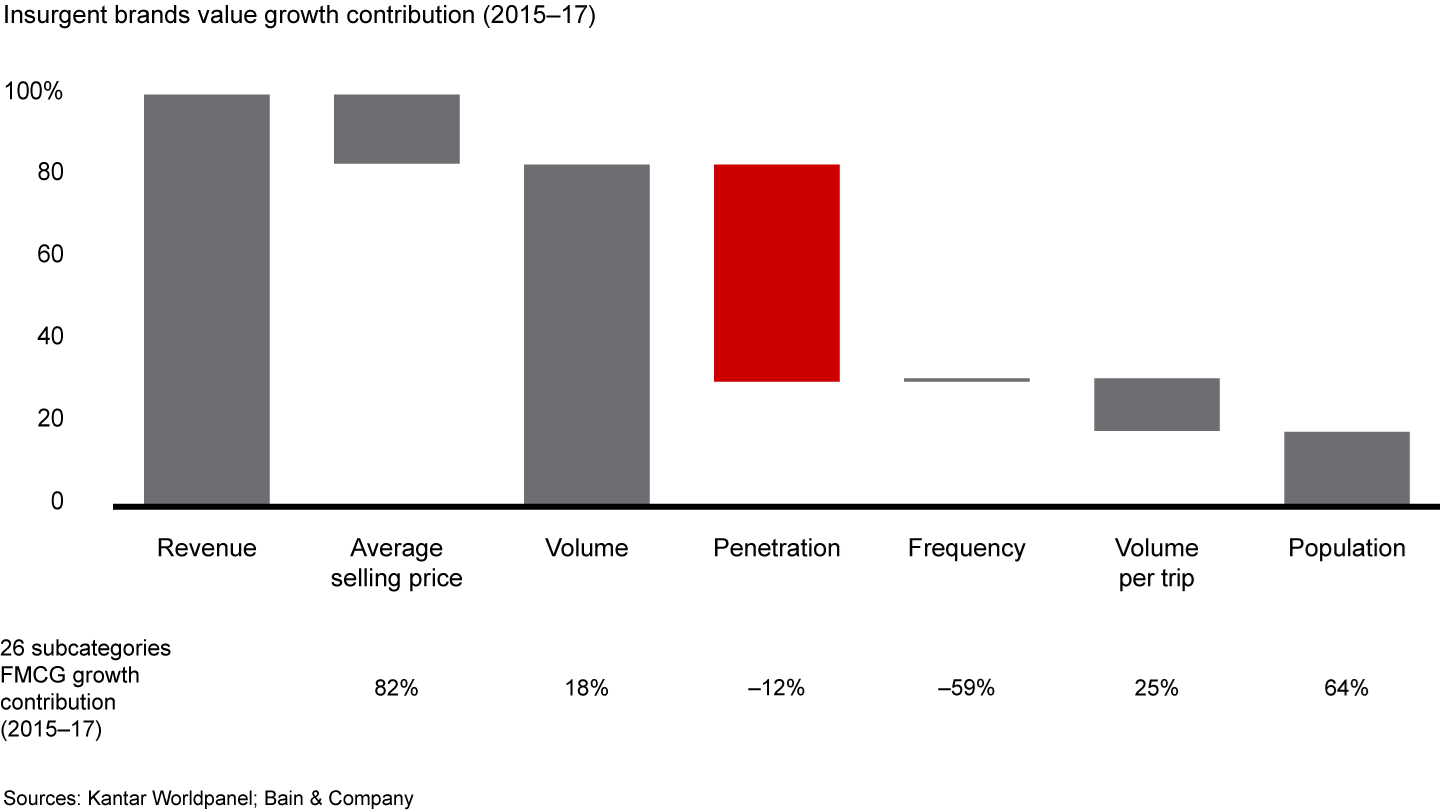
For Chinese insurgents, penetration is the single most important contributor to market share. It is an undeniable fact of life for FMCG companies of any size. The best way brands can grow over the long term is to grow their number of buyers. This is a key finding from the research of the Ehrenberg-Bass Institute for Marketing Science, summarized by Professor Byron Sharp, director of the Institute, in his book How Brands Grow, based on decades of observations of buying behavior. This is consistent with our previous studies (in particular, see China Shopper Report 2014, Vol. 1, Chinese Shoppers: Evolving Behaviors in a Challenging Environment, and China Shopper Report 2017, Vol. 2, Keeping Up with China’s Shoppers at Two Speeds).
True, many insurgent brands are growing penetration from a small base. They can make huge gains mostly by increasing distribution—an option not typically open to traditional incumbents. In addition, some insurgent brands in certain categories have been able to grow value by upgrading their offers to satisfy middle-class consumers, not through volume growth. That was the case with Pechoin, (百雀 羚), which benefited from an average 18% price increase in its skin care products from 2015 to 2017.
Three key external forces propelling insurgent brands. In addition to internal factors, a set of external forces is helping China’s insurgents flourish. Digitalization tops the list. The rapid growth of digitalization and advanced technology lowered the barriers to entry or expansion in China’s FMCG market—and there is a willing pool of venture capital eager to invest in small brands with big potential.
Another major external factor: the redefinition of consumers, merchandise and stores known collectively as “New Retail.” China’s consumers have growing expectations for tailored and specific offerings, which creates many niche opportunities for insurgent brands to capture. The traditional scale advantages of incumbents, such as large sales forces and large retail shelf space, have in some ways turned into disadvantages by digital disruption. For example, the e-commerce channel can reach millions of consumers without a single sales rep, and online platform advertising can reach millions of consumers with much lower budgets than traditional brands typically spend.
Finally, as we tracked in previous China Shopper Reports, Chinese consumers are showing a growing preference for healthy goods, a better quality of life and eco-friendly products. All of these require rapid product innovation and effective brand marketing, which are often more easily achieved by newer brands.
Winning with a Founder’s Mentality. Insurgents making the most of these external factors exhibit traits of what we refer to as a Founder’s Mentality: an insurgent mission, a frontline obsession and an owner’s mindset. We see this in three important areas. Local insurgents rely on consumer-focused innovation in product, branding and assortment. They take a localized approach to route-to-market and marketing. And they create a nimble and agile operating model. Marie Dalgar (玛丽黛佳) (see Case Study No. 1) and Unifon (御泥坊) (whose case study, especially around its digital strategy, is documented in a recently published book titled Smart Business, written by Ming Zeng, Alibaba’s chief strategy officer) are two insurgents that display many of the traits of a Founder’s Mentality. We’ll look at these three areas one by one.
-
Case Study No. 1: Marie Dalgar (玛丽黛佳)
How did insurgent brand Marie Dalgar (玛丽黛佳) become the local leader in makeup in China?
Think about the tough environment for any local player trying to make it in makeup in China. Nine of the top 10 brands by value are foreign brands like Christian Dior, Maybelline or Yves Saint Laurent, which have strong brand images, are known for their quality and beauty expertise, and are associated with prestige and a sense of fashion.
Yet, Marie Dalgar (玛丽黛佳) made all the right moves to rise above the pack. It innovated creative new products based on consumer needs, such as Black Tassel mascara and Dominoes eyeshadow. It has a strong focus on young consumers and builds products that are easy for them to use on different occasions. Having its own research and development centers and manufacturing bases allows Marie Dalgar (玛丽黛佳) to innovate and meet changing demands at China speed. It laid out an effective route-to-market plan that embraced China’s “New Retail” concept, taking a unique approach to increasing the consumer experience and building brand awareness. New Retail redefines store concepts. Marie Dalgar (玛丽黛佳)’s “TO GO” store features an augmented reality (AR) mirror to link offline consumers’ experience with their online purchase. The innovation boosts both offline and online sales.
The young makeup brand also took advantage of the expanding retail ecosystem by cooperating with third parties for special campaigns, and it outsourced sales efforts and found other ways to use partners’ e-commerce.platforms. For example, Marie Dalgar (玛丽黛佳) cooperated with KFC on campaigns and advertising on KFC channels, pulling in traffic from KFC’s huge consumer base. The campaign helped this insurgent makeup brand win 1.4 million visits on Tmall’s official store and make over RMB 12 million in sales, mostly from selling limited edition gift sets, which included both KFC coupons and lipsticks.
All of these steps helped make Marie Dalgar (玛丽黛佳) one of the best-selling local brands on Tmall and advanced the company onto the global stage: It became the first Chinese brand to sell its products in Sephora stores outside of China.
Product innovation, branding and assortment. Insurgents thoughtfully innovate in product and branding, focusing their assortment on proven “hero” SKUs or product variants that attract consideration and fulfill unmet needs of Chinese consumers.
Successful insurgents’ products fill a white space by delivering the perception of uniqueness for a targeted consumer segment. For example, QuanLinBenSe (泉林本色) successfully created the niche market of unbleached facial and toilet tissue (see Case Study No. 2). Or consider juice brand WeiQuan Daily C (味全每日 C), which sells its products in innovatively designed packaging—consumers collect the different themed bottles and are encouraged to share them on social media, spurring repeat sales (see Case Study No. 3). Some insurgent brands focusing on the “good-enough” consumer segment offer products that are perceived as both unique and value-for-money. Pechoin (百雀羚) emphasizes its products’ natural and herbal ingredients as well as their affordable price. Adolph (阿道夫), another haircare brand, sells innovative products with distinctive fragrances and brands them emotionally with a founder’s story that centers around the idea of “Scent of Love.”
-
Case Study No. 2: QuanLinBenSe (泉林本色)
How did QuanLinBenSe (泉林本色) create a new market segment in tissue?
One of the key ingredients of insurgents’ success is their ability to fill a white space by delivering the perception of uniqueness for a targeted consumer segment. This is how QuanLinBenSe (泉林 本色) rose above local and multinational brands alike by introducing the first unbleached natural tissue.
China’s facial and toilet tissue market has grown in value at about 6% annually since 2015. But the market is dominated by large traditional paper manufacturers with similar products: Most are highly bleached, strongly fragranced tissues that contain paper scraps. Enter insurgent QuanLinBenSe (泉林 色), which introduced the first unbleached natural tissue. It is made from wheat straw. The insurgent tissue company promoted it as being environmentally friendly and resource recyclable, serving consumers’ unmet need for healthy, natural and premium.tissue. Indeed, consumers were willing to pay more for it.
This insurgent invented the unbleached and natural tissue market and remains the leading brand in that segment. The move enabled QuanLinBenSe (泉林本色) to become a top-10 player in the Chinese tissue market, covering both the facial and toilet tissue markets, achieving 55% annual growth from 2015 to 2017.
-
Case Study No. 3: WeiQuan Daily C (味全每日C)
How did WeiQuan Daily C (味全每日C) grow in a flat category?
When growth stalled in the juice category in 2015, beverage companies started searching for new ways to reinvigorate sales. Insurgent brand WeiQuan Daily C (味全每日C) outperformed with a combination of innovative packaging and strategic social media promotions.
The young beverage brand replaced its own logos on bottles with clever and encouraging phrases such as Sorry that you are working late tonight but please drink some juice. Consumers found the labels endearing. WeiQuan Daily C (味全每日 C) also packaged juice in bottles with labels that contained a single word. Consumers could combine multiple bottles to compose their own sentences, an activity that generated repeat sales.
WeiQuan Daily C (味全每日 C) took an equally unique approach to promoting its brand on social media. For example, it collaborated with MIGU Reading (咪咕阅读), a leading Chinese online reading platform, to launch its “Say Hi to a Better Self” campaign. Consumers using WeChat could customize their own Daily C bottle with their nickname, gender, favorite flavor and favorite book. The campaign fulfilled consumers’ personalization needs and went viral.
Such innovation enabled WeiQuan Daily C (味全每日 C) to outperform the juice category, with 20% annual growth from 2015 to 2017, and earned it distinction as “consumers’ favorite juice brand,” according to the business magazine CBNweekly, for four years in a row.
These winning companies choose branding that speaks to the fundamental needs of their targeted Chinese consumers. For example, some appeal to the emotional and life-changing benefits of their products. Packaged water brand Ganten (百岁山) promotes itself with words like “royal” or “pure” and has sponsored major sports events such as, currently, FIVB Volleyball Women’s Club World Championship, to appeal to quality-conscious and health-conscious consumers of premium products. By comparison, insurgents in the good-enough segment use emotional slogans or advertising campaigns that resonate well with consumers who are less sensitive to status. Skin care and makeup brand Chando (自然堂) used its classic slogan “You are already beautiful” to create a strong link between Chando (自然堂) and natural beauty among mainstream female consumers.
Another key to the success of high-growth insurgents is their decision to narrow product assortment. They typically focus on one or two hero SKUs or product variants that target or create the white space of a category. More than half of the insurgents we examined derive a large proportion of their total revenue from these heroes. Focusing on a narrowed assortment helps them accomplish two important goals: It eliminates unnecessary product complexity and ensures that an insurgent brand’s limited resources are devoted to a very focused message to the target consumers.
YNBY (云南白药) puts its muscle behind product development and marketing efforts for two hero SKUs—its Mint and Spearmint toothpaste products, which uniquely combine Traditional Chinese Medicine and modern oral care ingredients. These two product variants account for 70%–75% of YNBY (云南白药)’s toothpaste sales (see Figure 10).
Compared with big local brands or multinationals, some insurgents generate a larger share of their revenues from hero product variants

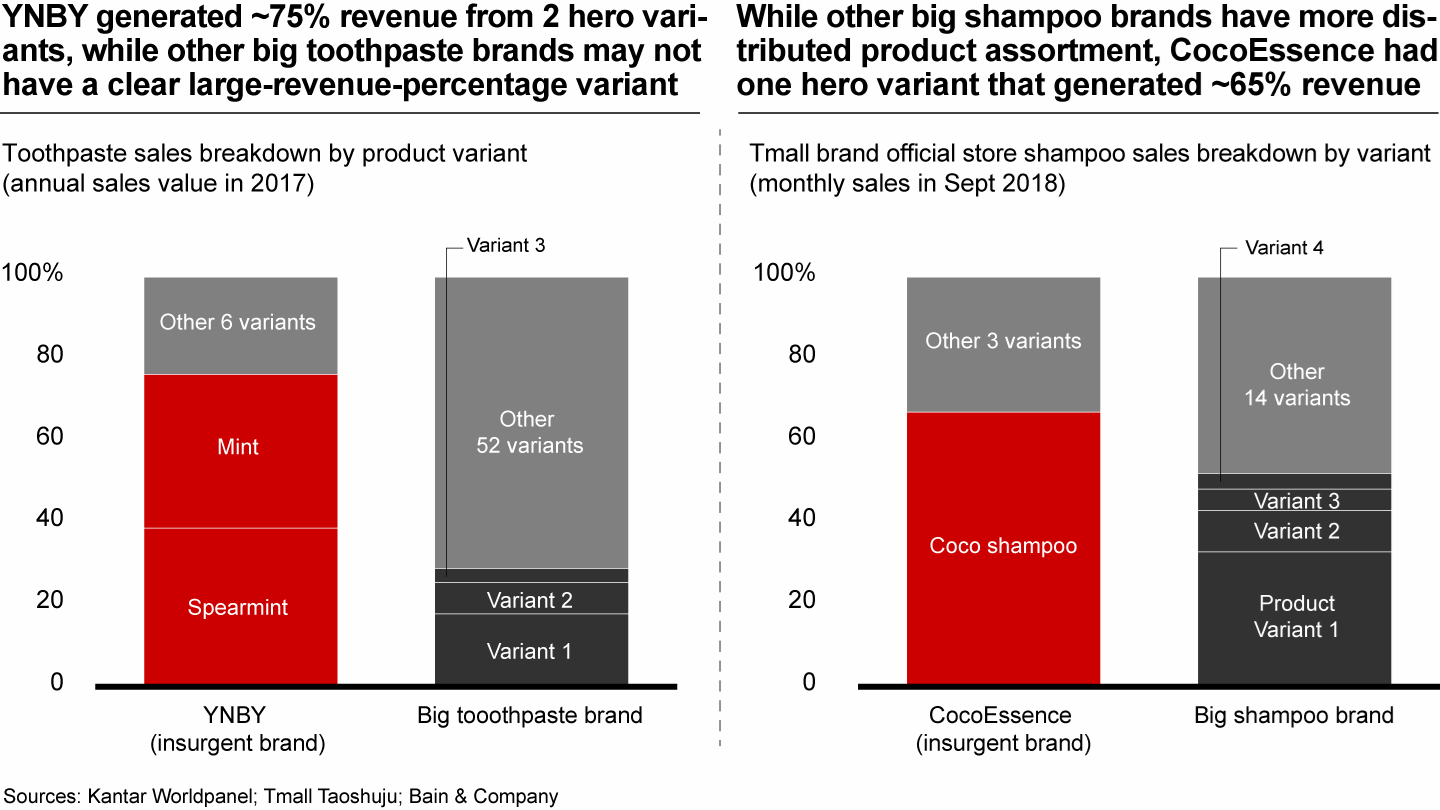
Route-to-market and marketing. Another secret behind insurgents’ quick success: They take highly localized route-to-market and marketing approaches. They embrace new and alternative channels, selectively choose geographies for entry, and incorporate popular Chinese elements when marketing or generating consumer engagement.
Unlike large multinationals that can draw on massive resources for traditional distribution and marketing channels, insurgent brands are more restricted from the start. However, that becomes an advantage for them. China’s New Retail has brought with it many nontraditional distribution and marketing channels. Chinese insurgents build strong roots in those channels, in a localized way. Most of them also enjoy the benefits of not being constrained by an established route-to-market infrastructure; they have the flexibility to adopt or switch to new and alternative channels at will.
Without established offline distribution relationships, many insurgents shift their focus to high-traffic online platforms such as Tmall and JD.com, even using those platforms to promote and sell products directly to consumers. These online engagements help brands quickly gain exposure and visibility among millions of potential consumers. Most insurgent brands also conduct localized content and topic marketing through popular social media and online platforms in China, notably Weibo, WeChat and the Chinese music video platform TikTok (Douyin, 抖音).
It’s not an accident that juice brand WeiQuan Daily C (味全每日 C) is achieving record-setting growth and has earned distinction as consumers’ favorite juice brand in research conducted by CBNweekly for four years in a row. The brand conducted multiple content campaigns to continuously gauge interests among online consumers. Among the successful campaigns: “Say Hi to a Better Self ” with MIGU Reading (咪咕阅读), a leading Chinese online reading platform; “Words Combination” with key opinion leaders through Weibo and WeChat; and the “Say Love” bottle. It also sponsors the popular TV series Love O2O (see Case Study No. 3).
Unlike established brands, most young insurgents do not feel the immediate pressure to launch products nationally. They have the luxury of selecting the right strategic market to enter. They test and refine their products in those markets, building consumer advocacy and brand image before expansion. This is the approach favored by many insurgent brands appealing to the good-enough segment. Among the insurgents we evaluated, more than half launched their products in lower-tier cities, a move that enables them to avoid early competition from multinational brands.
According to Kantar Worldpanel data, even today, many “good-enough” insurgents still have a higher penetration rate in lower-tier cities. Founder Qichuan Zhuang made the strategic decision to sell fabric detergent brand ChaoNeng (超能) in lower-tier cities, where he would encounter less direct competition from brands such as Tide and Omo. ChaoNeng (超能) was heavily marketed in Tier-3–Tier-5 cities as a cost-effective brand, gaining strong recognition, which eventually helped ChaoNeng (超能) expand to Tier-1–Tier-2 cities (see Figure 11).
Most “good-enough” insurgent brands established roots in lower-tier cities, even more so than other top-performing brands

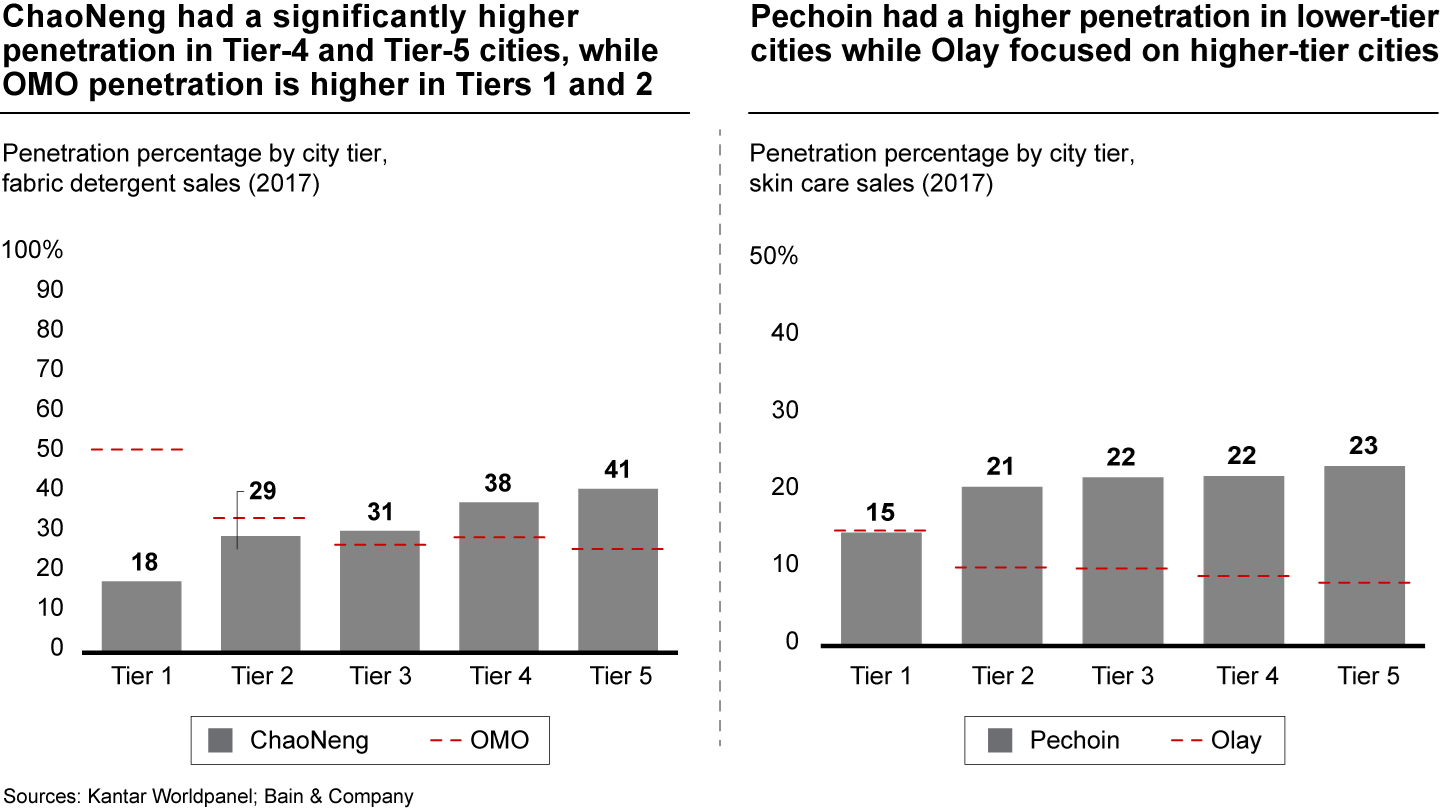
Insurgents also take a uniquely Chinese approach to marketing and consumer engagement. They typically rely on celebrities, hot TV series, reality shows and key opinion leaders to increase exposure to mass audiences, both online and offline. Snack brand Three Squirrels (三只松鼠) collaborated with the popular TV show Ode to Joy, whose lead actress was hired as the brand’s spokeswoman. The soft-marketing approach worked very well with the post-’90s generation, the snack brand’s target market. Similarly, Pechoin (百雀羚) heavily invested in popular reality shows such as The Voice of China in 2012–15 and Ice Fantasy, an epic drama hugely popular with Chinese youngsters, in 2016. It also hired a Taiwanese superstar, Jay Chou, as its brand ambassador to enhance brand recognition (see Case Study No. 4).
-
Case Study No. 4: Pechoin (百雀羚)
How did local brand Pechoin (百雀羚) get its voice heard over multinationals?
In skin care, multinationals invest so heavily to build their brand awareness through advertisements that local companies struggle to compete, especially among young and premium segment consumers. This lack of brand recognition is reflected in low revenue growth for most local brands.
Insurgent Pechoin (百雀羚) took a local approach to building interest in its brand. To complement traditional TV advertisements, it invested heavily to sponsor popular TV reality shows such as The Voice of China in 2012–15 and Ice Fantasy, an epic drama that is popular with young Chinese viewers, in 2016. To expand its appeal to younger consumers, it hired celebrities Jay Chou and Bingbing Li as brand spokesmen, even using Chou’s lyrics to promote the purchase of Pechoin (百雀羚) products as gifts for parents.
While most other brands focus on simple SKU advertising and basic descriptions in online advertising, Pechoin (百雀羚) conveys localized content and unique brand stories, creatively using multiple social media platforms and online video sites. For example, the Old Shanghai–style campaign “1931” on WeChat strongly contributed to Pechoin (百雀羚)’s brand awareness, reaching tens of millions of people on WeChat in a few days. Its promotion, which included a live performance by singer Chenyu Hua on its mobile app, attracted more than 5 million views. Its recent crossover branding with the Forbidden City, balancing Chinese tradition and fashion, is well received by young consumers. The high level of wareness created by these and other marketing efforts has helped Pechoin (百雀羚) become the leading local skin care brand.
For their part, good-enough insurgents often focus their marketing on hosting local events—an option that generates consumer engagement but requires smaller investment. For example, Firmus (飞鹤), an infant formula brand, hosted parent-child “space carnival” events in shopping malls in eight major cities. It proved to be an effective way for Firmus (飞鹤) to meet its targeted consumers, showcase its parenting expertise and encourage both on-the-spot and future sales.
In addition, we see many insurgent brands taking advantage of the creative opportunities made possible by New Retail. They are rolling out interactive shopping experiences and investing in personalized online advertising. When makeup brand Marie Dalgar (玛丽黛佳) introduced its automated “TO GO machine” and augmented reality (AR) mirror, it wowed store consumers with a novel shopping experience—and immediately boosted sales.
An agile operating model. Because they are young and entrepreneurial, most insurgent brands retain a nimble organization with an owner’s mindset. They outpace incumbents by having lean, cross-functional organizations that give them the flexibility and the freedom to adapt in-market. Instead of waiting for multilayers of discussions and approvals, insurgent brands can move quickly. They have the advantage of being able to test and learn—and rapidly change course as needed without locking in significant capital expenditures. For example, Bestore (良品铺子), a leisure snack brand, employs a flexible product development process that allows parallel cross-functional collaborations and frequent communication of consumer insights. It also adopts a test-and-learn product development approach before scaling production (see Case Study No. 5).
-
Case Study No. 5: Bestore (良品铺子)
How does Bestore (良品铺子) pivot so quickly?
Things move fast in China’s snack food category. The three top-performing brands—Three Squirrels (三只松鼠), LYFEN (来伊份) and Bestore (良品铺子)—all compete fiercely by constantly developing and launching new, convenient and healthy products for mass consumers. Bestore illustrates the well-oiled machinery behind this constant flow of new products.
Bestore (良品铺子) designed a flexible operating model that allows two “forces” (category product managers and marketing/channel teams) to work together to expedite new product development. Teams from both sides participate in monthly new-product-sharing meetings, and rely on a test-and-learn approach. For example, they conduct small consumer tasting events before scaling production of a proposed new product. All teams collaborate closely and communicate quickly to respond to consumer needs. Specific task forces conduct deeper consumer research for important “hero” SKUs such as small-pack pork jerky. More important, the company links product managers’ bonuses to category performance—thus giving managers an owner’s mindset motivation.
Bestore (良品铺子) works in China time. It can shorten the new product development cycle to two months for some snack products. In all, the insurgent company introduces roughly 400 new SKUs each year. Now one of the best-selling snack food companies in China, Bestore (良品铺子) saw revenues grow by an average annual 31% from 2015 to 2017.
Remain asset light and use other partners in the ecosystem. Insurgents win by establishing an ecosystem of partnerships, including co-manufacturers and co-marketers, allowing them to remain asset light themselves. Instead of building every distribution and marketing channel on their own, insurgent brands strategically form partnerships with online platforms, taking advantage of their resources and traffic to attract consumers. Yogurt brand SanYuan (三元) collaborates with JD.com to benefit from the e-retailer’s “unbounded retail” program, in which SanYuan (三元) gleans JD’s market data. In addition, front-page promotion on the platform boosts SanYuan (三元) sales. Indeed, by forming such deep partnerships, insurgents normally gain access to additional market-trend analysis and a prioritized listing or search ranking. In essence, they are outsourcing some of their sales efforts to external parties. The strategy has allowed Three Squirrels (三只松鼠), Chando (自然堂), Marie Dalgar (玛丽黛佳), Kans (韩束) and Unifon (御泥坊) to be ranked as the monthly top-three sales brands multiple times in their relevant categories on Tmall or JD.com.
The 3D approach to outsmarting insurgents in China
Incumbent FMCG brands—both multinational and domestic—have a lot to learn from insurgents. Instead of continuing to lose so much growth to these newcomers, incumbents can compete more effectively by adopting three critical ingredients of insurgents’ success. We call it the 3D approach.
Design for Chinese consumers. Chinese FMCG consumers are unique among their counterparts in other markets. What they need and how they engage are different from consumers in developed markets or other emerging markets. They also are changing fast. As such, incumbents—especially multinationals—should be intensely devoted to localizing in everything from product design to branding to marketing. This is a lesson Unilever has learned. It opened an R&D center in Shanghai, one of six such centers worldwide, in 2009. This center enables Unilever to understand Chinese consumers’ needs better, respond to Chinese market changes more quickly and be more innovative in locally relevant product design. The facility brings together cutting-edge technology and expertise in pilot plants, labs (analytical, sensory and packaging) and consumer insight capabilities.
Another important consideration is the composition of a company’s team. Global experience is important, but what is often more valuable is a local team that deeply understands both the Chinese culture and the latest trends: the significance of Traditional Chinese Medicine, for instance, or the shopping behaviors of the Chinese millennials born under the one-child policy, or the importance of product quality and need for traceability.
Decide in China. The Chinese FMCG market is moving so swiftly that by the time a decision rises from the local to regional to global headquarters for an approval, a brand is likely to have missed out on an opportunity to a more nimble insurgent competitor. That’s just one of the reasons that multinationals need to delegate product, marketing, distribution and other decisions affecting their China business to their China teams.
There are numerous other reasons why we caution multinationals to avoid having global headquarters force their China business to use or adapt global approaches and solutions. For example, the Chinese market is so big that a multinational can reap the benefits of scale within its borders alone. The fundamental question for multinationals is whether the benefits of their global scale can more than compensate for the lack of local speed, both in decision and execution. Evidence so far suggests that the answer is no.
Headquarters should provide tailwinds instead of headwinds to the China team by either delegating decision rights to the team or colocating to China. The same principle can be applied for the operating model within China. China is not a homogenous consumer market but one with clear differences across provinces and city tiers. Take a lesson from local insurgent brands. Within the boundaries set out by their China headquarters, the local teams of some of these Chinese insurgents are empowered to make decisions in areas such as marketing and distribution to respond to the specific needs of local consumers.
Do it at Chinese speed. Undeniably, speed is in the DNA of local insurgents. While traditional brands by their nature are typically less nimble, they can take two proven approaches to improve their ability to act quickly on market opportunities: rely on ecosystems and deploy micro-battles.
To understand the potential of ecosystems, think about how scale insurgents like Tencent and Alibaba grow and gain market power. For them, leadership no longer is defined by the assets the company owns, but rather by its role in the ecosystem that surrounds them. In the past, they undoubtedly would have gained scale by building capacity and acquiring assets within the organization. That approach to scaling up worked well during the years in which market changes happened at a slow and steady pace, and when organizational boundaries within the value chain were more clear-cut.
With the rise of platform companies and digitalization, changes occur far more swiftly than ever and organizational boundaries become blurred. So, many insurgents grow fast by setting up an ecosystem, establishing a role there, and making use of other resources within the ecosystem. It is an option open to incumbents, too. For example, an FMCG company can focus on core functions such as product development and marketing while relying on players in the ecosystem for other functions, such as manufacturing and distribution.
Or, a brand can use the ecosystem to help speed products to market in record time. In recent months, Unilever acted on Alibaba consumer data that pointed to the need for an affordable, antipollution skin cleanser. It developed 48 different product prototypes, market-testing them on Alibaba’s online malls Taobao and Tmall, before introducing Purifi line, starting with a skin cleanser based on the purchasing decisions of tens of thousands of young mothers. The entire process of conception, design and testing took Unilever just 6 months with Alibaba’s help, down from the usual 18 months to two years for a new product.
The other way to make big consumer products companies more agile: deploy micro-battles—small, achievable battles that later can be scaled. The micro-battle approach involves an extremely focused initiative that starts by attacking the hardest problem first and iterates on the solution. Micro-battles are distinct from typical strategic initiatives in several ways. First, they are run by small, cross-functional teams that operate in an agile manner and are empowered to progress and make recommendations. Second, every micro-battle has clearly defined deliverables that can scale. Third, the teams are devoted to test and learn, with a willingness to fail fast and adapt—this is invaluable in China and other rapidly changing markets.
Consider the experience of AB InBev in China. It applied the micro-battle approach to become the top imported beer player in China. The company prototyped the whole route to affluent consumers in three cities, starting by understanding consumer needs, which helped to identify the relevant specific occasions and trendy channels. Then, it created a new route to market with dedicated distributors that could win in those channels in those three cities. After several trials and adjustments, the company realized that to succeed, it needed to create a whole new company, separate from the current business, which became a true “Engine 2” when rolled out to 120 cities.
The effort is teaching AB InBev a valuable lesson: Even for a huge and established company, it is possible to quicken the pace and prevent insurgents from taking over the fast lanes in China’s two-speed FMCG market.
1 These 26 categories are a) packaged food: biscuits, chocolate, instant noodles, candy, chewing gum and infant formula; b) beverages: milk, yogurt, juice, beer, ready-to-drink tea, carbonated soft drinks (CSD) and packaged water; c) personal care: skin care, shampoo, personal wash, toothpaste, makeup, hair conditioner, diapers and toothbrushes; and d) home care: toilet tissue, fabric detergent, facial tissue, kitchen cleanser and fabric softener.
About the authors
Bruno Lannes and Derek Deng are partners with Bain & Company’s Consumer Products and Retail practices, and are based in Shanghai. Marcy Kou is CEO at Kantar Worldpanel Asia. Jason Yu is managing director at Kantar Worldpanel Greater China.
Acknowledgments
This report is a joint effort between Bain & Company and Kantar Worldpanel. The authors extend gratitude to all who contributed to this report, in particular Simon Wong, Christina Ye and Jane Jin from Bain, and Rachel Lee, Tina Qin, Robin Qiao and Lorna Peng from Kantar Worldpanel.
Founder’s Mentality® is a registered trademark of Bain & Company, Inc.

There’s Only One Way to Break into China’s Crowded Retail Market
You'll have to partner with Alibaba or Tencent.